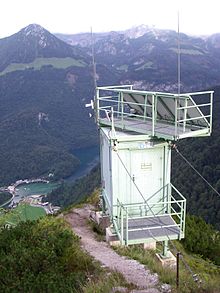GALILEO test and development environments
The German GALILEO Test and Development Environment ( GATE , GALILEO Test and Development Environment ) are test infrastructures that simulate the radio signals of the future European satellite positioning system Galileo with terrestrial radio systems.
GATE (Berchtesgaden)
For this purpose, first six, since 2010 eight transmission systems ( pseudolites ) were installed on the mountains in the Berchtesgaden region , which emit Galileo signals within the enclosed area over a total usable area of around 65 km² . Two monitor receivers (GMS) are installed in the center of the test area in the GATE operations office. Thanks to its infrastructure, GATE is able to generate the navigation signals of the Galileo satellites, to simulate natural influencing factors (e.g. influences from the ionosphere , troposphere , etc.) and to change signal types and strengths as required. GATE provides several modes of operation specially tailored to different users. The core is the so-called Virtual Satellite operating mode (VSM). The transmission stations are configured in such a way that they imitate the signals of a Galileo satellite as if they were transmitted by real satellites in orbit: For this purpose, the transmission stations transmit the orbital data of virtual satellites at the right time with the appropriate frequency and phase. By taking into account the dynamics of the user and the calculated satellite movements, signals are generated which - apart from the physical direction of propagation - cannot be distinguished from a “real” Galileo satellite signal.
Since autumn 2008, a few years before Galileo was fully available , GATE has enabled field tests for receiving devices to determine position with Galileo signals under realistic conditions, including typical interference such as B. Multipath effect . The broadcasting stations, which are located near the mountain peaks of the Grünstein , the Toten Mannes (Hirschkaser), the Berchtesgadener Hochthrons , the Kneifelspitze , the Kehlstein and the Jenner have a height difference of up to 1,250 meters to the valley. In autumn 2010, two additional transmitter stations were put into operation, namely at locations on the Rauhen Kopf and the Brettgabel . Since the mountains are in all directions around Berchtesgaden, a good horizontal accuracy can be achieved. The GATE accuracy for horizontal real-time navigation with good HDOP (Horizontal Dilution of Precision) is better than 10 m (2 Sigma). This accuracy is guaranteed to the user for the Galileo frequencies E1 and E5.
Because of its variable structure, the test environment is available to a wide range of users. GATE concentrates with its offer on the free Galileo service, the "Galileo Open Service", which is decisive for the so-called land mobile market. The target groups are primarily those users who want to test and optimize their products before the final launch of Galileo, e. B. Manufacturers of receivers for Galileo or Galileo / GPS , developers of applications and services as well as professional users of navigation and positioning technologies.
GATE also enables RAIM integrity tests ( Receiver Autonomous Integrity Monitoring ) to be carried out, which are aimed at the ESA's new Galileo integrity concept . On a functional basis, Galileo receivers, for example, can be tested with regard to the detection and processing of so-called “feared events” - errors in the satellite signals that lead to a degradation of the position accuracy.
The construction of the test environment was financed by the German Aerospace Center (DLR) with funds from the Federal Ministry of Economics and Technology (BMWi) (funding code: 50NA0802). GATE has been operated by IFEN GmbH on behalf of DLR since January 2011.
The official opening of the test environment, expanded to eight stations, took place on February 4, 2011 in Berchtesgaden.
SEA GATE (Rostock)
The SEA GATE is a test environment in the port area of Rostock.
aviationGATE (Braunschweig)
The aviationGATE is a planned test area at Braunschweig-Wolfsburg Airport .
railGATE (Wegberg-Wildenrath)
The railGATE was built specifically for the development of rail applications. The railGATE is integrated into the infrastructure of the Wegberg-Wildenrath (PCW) test center and is located 60 kilometers from Aachen. It has a total of eight pseudolites. A total of two test rings and various test tracks are available on which various driving situations can be tested at different speeds with a wide variety of rail vehicles. The oval, outer ring of the PCW is about 6 kilometers long, the inner ring is about 2.5 kilometers long. In the center there is a shunting area with several shunting tracks. The Galileo pseudolites are evenly distributed around the outer test ring.
The construction of the test environment was financed by the German Aerospace Center (DLR) with funds from the Federal Ministry of Economics and Technology (BMWi) (funding code: 50NA0902). The official opening took place on May 22, 2015 together with the opening of the automotiveGATE.
automotiveGATE (Aldenhoven-Siersdorf)
AutomotiveGATE is located on the grounds of the Aldenhoven Testing Center (ATC) of RWTH Aachen University in Aldenhoven-Siersdorf. The area is about thirty kilometers from Aachen and allows the testing and use of Galileo signals for a variety of automotive applications in which real-time control and safety aspects are in the foreground. These include, for example, driver assistance, automatic collision avoidance and autonomous driving. In total, the test site is supplied with Galileo-compliant signals by means of six pseudolites. The pseudolites are arranged around the test area so that the entire area is homogeneously covered with signals.
The construction of the test environment was financed by the German Aerospace Center (DLR) with funds from the Federal Ministry of Economics and Technology (BMWi) (funding code: 50NA0902). The official opening took place on May 22, 2015 together with the opening of railGATE.
See also
Individual evidence
- ^ Report in the Berchtesgadener Anzeiger from September 1, 2010 on the expansion of the GATE

